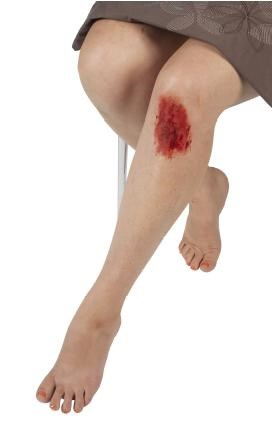Back First Aid Explained
Bleeding
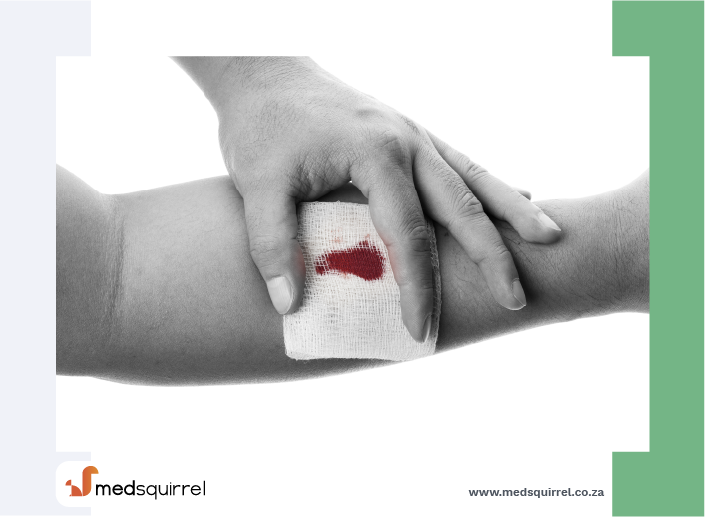
We have selected the following expert medical opinion based on its clarity, reliability and accuracy. Credits: Sourced from St Johns New Zealand. Please refer to your own medical practitioner for a final perspective, assessment or evaluation.
Overview
Bleeding is usually minor in nature but can sometimes impose serious threat if a large vein or artery has been injured.
External bleeding
Background
Generally, bleeding is of a minor nature and includes small cuts, grazes, etc.
However, bleeding may be severe and life threatening if a large vein or artery has been injured (e.g. the jugular vein in the neck).
Some wounds are associated with other injuries beneath the skin (e.g. an organ injured by a stabbing; broken bones which have pierced the skin).
Symptoms and signs
Note: not all signs and symptoms may be present
- a wound with, or without, an embedded foreign object
- pain from skin surface wounds
- bruising or discolouration of the skin
- loss of normal function in the injured area
- pale, cold, sweaty skin
External bleeding
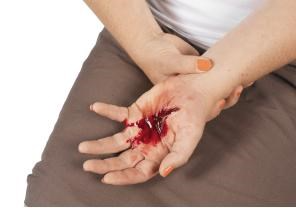
How you can help
1. Apply direct pressure to the bleeding wound
- Apply firm pressure over the wound: Use a sterile or clean bulky pad and apply it firmly with hand pressure. Apply a bandage to keep the dressing in place.
- If bleeding is severe, DO NOT waste time looking for suitable padding, but be prepared to use the patient's hand or your hand to hold the wound together if the patient is unable to do this unaided.
Apply direct pressure to the bleeding wound
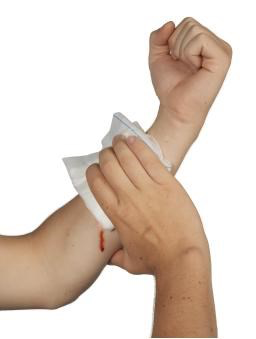
2. Raise the injured area
- If the wound is on a limb, raise it in a supported position to reduce blood flow to the injured area.
- If an arm is injured, you could apply an arm sling or elevation sling.
Try to avoid any direct contact with the patient's blood or other body fluids. Use disposable gloves if possible. If gloves are not available, place your hands inside a plastic bag.
- If there has been any contact with blood or any other body fluids, wash your hands or any blood splashed on the skin thoroughly with soap and water as soon as possible after the incident.
- If you are concerned about a possible risk of infection, obtain advice from your doctor as soon as possible.
Raise the injured area
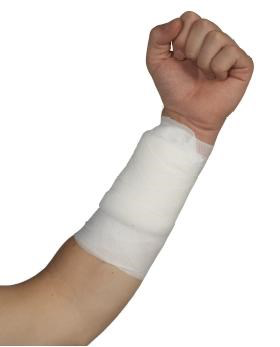
3. If a foreign body is embedded in the wound
- DO NOT remove it but apply padding on either side of the object and build it up to avoid pressure on the foreign body.
- Hold the padding firmly in place with a roller bandage or folded triangular bandage applied in a criss-cross method to avoid pressure on the object.
DO NOT remove the foreign object, but apply padding on either side
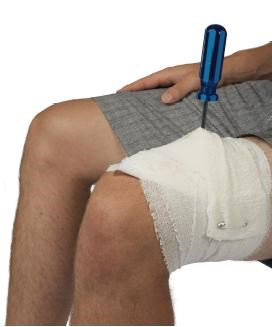
4. Keep the patient at total rest
Even if the injury involves the arm or upper part of the body, the patient should rest in a position of greatest comfort for at least 10 minutes to help control the bleeding.
5. Seek medical assistance (See "EMERGENCY NUMBERS" above)
If the wound appears to be minor and the patient is able to travel by car, arrange an urgent appointment with a local doctor to assess and treat the injury.
If the injury is severe or the patient is very unwell, CALL 10177 for an AMBULANCE as soon as possible (See "EMERGENCY NUMBERS" above).
While waiting for an ambulance to arrive, observe the patient closely for any change in condition.
6. If blood leaks through the pressure pad and bandage
- Apply a second pad over the first: Use a tea towel or similar bulky fabric and apply maximum pressure to the area.
- For major uncontrolled bleeding quickly: Remove the blood-soaked pad and bandage and replace with a fresh bulky pad and bandage. The continuing bleeding may be due to the pad slipping out of position when the first bandage was applied.
If blood leaks through the pressure pad and bandage
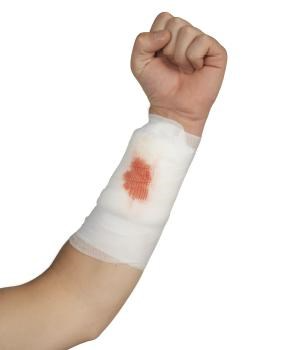
Wounds that need special care
Amputation
How you can help
Call 10177 for an AMBULANCE. (See "EMERGENCY NUMBERS" above).
1. Control any bleeding
Use a bulky pad and apply it firmly to the bleeding area. Raise if possible.
Control any bleeding
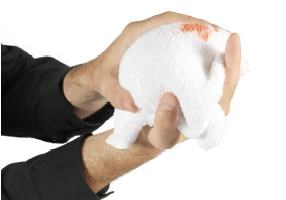
2. Recover the severed part
- If possible, gently place it into a plastic bag. Seal the bag with a little air inside to protect the severed part with a ?cushion? of air.
- Place the inflated bag into a container or bucket of cold water to which several ice cubes have been added.
- Ensure the severed part is transferred to hospital with the patient.
Crush injury
Background
A crush injury occurs from compression of large muscle groups and soft tissues by a heavy weight. The most serious sites for a crush injury to occur are the head, neck, chest, abdomen and thigh.
How you can help
Call 10177 for an AMBULANCE. (See "EMERGENCY NUMBERS" above)
1. Remove the crushing force
- Remove the crushing force if possible because permanent tissue damage may occur with severe crushing force.
- If the crushing force has been in place for some time, be prepared to give prompt first aid, because removal of the crushing force may cause a sudden collapse or deterioration in the patient?s condition.
2. Treat the patient's injuries
- Assess and treat any injuries in order of their importance.
- Control any bleeding with a sterile pad applied firmly to the injured area.
- Assist the patient into the position of greatest comfort and use soft padding to provide support for the injured part.
- If a limb is involved, support and immobilise the injured area.
- While waiting for the ambulance to arrive, observe the patient closely for any change in condition.
Nose bleed
Background
A blow to the nose, flying at high altitude, or scuba diving may all cause a bleeding nose.
For a child, always check whether there is a foreign body present ? e.g. a bead or coin. If this has occurred, seek prompt medical advice and DO NOT try to remove the object yourself because this may cause further damage.
If bleeding is due to a head injury (e.g. a fractured skull), CALL 10177 for an AMBULANCE urgently. (See "EMERGENCY NUMBERS" above)
How you can help
1. Apply firm pressure, elevation and rest
- The patient needs to hold the head well forward and breathe through the mouth while pinching the entire soft part of the nose for 10 to 20 minutes.
- The patient must be sitting down and at total rest until the bleeding stops.
Apply firm pressure, elevation and rest
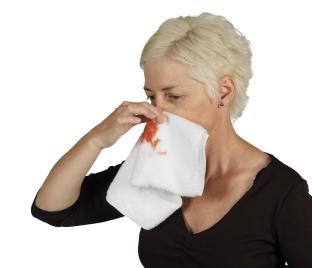
If bleeding continues after 20 minutes of pressure, continue the pressure and CALL for an AMBULANCE. (See "EMERGENCY NUMBERS" above)
A cold compress can be used.
2. Once the bleeding has stopped
Tell the patient not to blow their nose for a few hours because this may restart the bleeding.
Other wounds
An abrasion (graze)
How you can help
- Gently clean with soapy water or saline. If there are pieces of gravel embedded in the wound, ask the patient to try to remove them while the area is soaking in soapy water.
- Dry the area well by blotting with gauze swabs or a pad of tissues.
- If a protective dressing is necessary, apply a non-adherent sterile dressing and fix it in place with a light roller bandage or tape.
An abrasion (graze)
A puncture wound
How you can help
- Clean the wound with warm soapy water and allow it to penetrate the puncture track because tetanus spores may be trapped deep in the wound.
- Allow the wound to dry thoroughly in the air before covering it.
- If a protective dressing is needed, use a porous adhesive dressing and change it daily to keep the wound healthy and dry.
Contact a local doctor for advice about tetanus immunisation.
A puncture wound

Internal bleeding
Background
Internal bleeding is often difficult for the first aider to recognise. This type of bleeding can occur without an obvious wound and can be very serious as it is difficult to stop without surgical intervention.
Internal bleeding occurs when blood vessels within the body are ruptured and blood escapes out of the circulatory system. It may follow such incidents as a blow to the head, chest, or abdomen due to a fall or being struck by a vehicle.
Internal bleeding should be suspected when blood is seen in vomit, urine, sputum or faeces.
Symptoms and signs
Note: not all signs and symptoms may be present
- Rapid and 'gasping' breaths
- Increasing thirst
- Frothy red blood coughed up from the lungs, blood-stained vomit like ?coffee grounds?, red or rust-coloured urine, or dark faeces like tar
- Pale, cold, sweaty skin
How you can help
1. Place the patient at total rest
- Assist the patient into the position of greatest comfort.
- Cover the patient with a blanket to maintain body heat.
- Place protective fabric underneath the patient if the surface is rough, cold or hot ? e.g. a coat if the patient is lying on a road.
CALL 10177 for an AMBULANCE. (See "EMERGENCY NUMBERS" above)
2. While waiting for the ambulance
- Manage any other injuries.
- Ensure that all restrictive clothing has been loosened, especially at the neck and waist.
- Keep any bystanders clear.
- Reassure the patient.
- DO NOT allow the patient to eat, drink or smoke.
_______________________________________________________________________________________________________________________
Are you a healthcare practitioner who enjoys patient education, interaction and communication?
If so, we invite you to criticise, contribute to or help improve our content. We find that many practicing doctors who regularly communicate with patients develop novel and often highly effective ways to convey complex medical information in a simplified, accurate and compassionate manner.
MedSquirrel is a shared knowledge, collective intelligence digital platform developed to share medical expertise between doctors and patients. We support collaboration, as opposed to competition, between all members of the healthcare profession and are striving towards the provision of peer reviewed, accurate and simplified medical information to patients. Please share your unique communication style, experience and insights with a wider audience of patients, as well as your colleagues, by contributing to our digital platform.
Your contribution will be credited to you and your name, practice and field of interest will be made visible to the world. (Contact us via the orange feed-back button on the right).
Disclaimer:
MedSquirrel is a shared knowledge, collective intelligence digital platform developed to share medical knowledge between doctors and patients. If you are a healthcare practitioner, we invite you to criticise, contribute or help improve our content. We support collaboration among all members of the healthcare profession since we strive for the provision of world-class, peer-reviewed, accurate and transparent medical information.
MedSquirrel should not be used for diagnosis, treatment or prescription. Always refer any questions about diagnosis, treatment or prescription to your Doctor.

